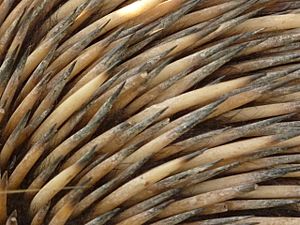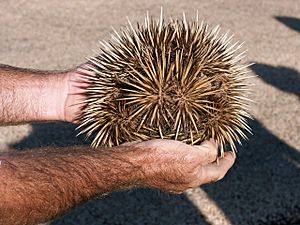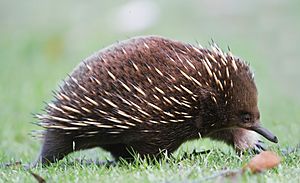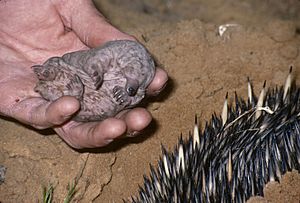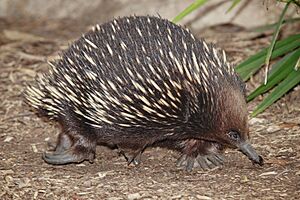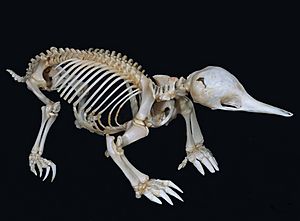Short-beaked echidna
Quick facts for kids Short-beaked echidna |
|
|---|---|
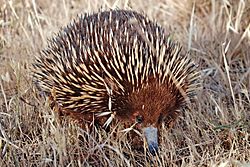 |
|
| Conservation status | |
| Scientific classification | |
| Kingdom: | |
| Class: | |
| Subclass: | |
| Order: | |
| Family: | |
| Genus: |
Tachyglossus
|
| Binomial name | |
| Tachyglossus aculeatus (Shaw, 1792)
|
|
The short-beaked echidna (Tachyglossus aculeatus) is a unique animal. It is the only member of its genus and one of four living species of echidna. People also call it the spiny anteater because it loves to eat ants and termites.
This amazing creature is covered in both soft fur and sharp spines. It has a special long nose, called a snout, and a super-fast tongue. These tools help the echidna catch its food very quickly. Like other monotremes, the echidna lays eggs instead of giving birth to live young.
Short-beaked echidnas live all over Australia. You can also find them in parts of southwestern New Guinea, especially near the coast and in the mountains. In Australia, it is one of the most common native mammals. Even though it is not in danger of extinction, some human activities have reduced where it lives. These activities include hunting, destroying its habitat, and bringing in new predators or parasites.
Contents
What is a Short-Beaked Echidna?
The short-beaked echidna was first officially described in 1792. Its scientific name, Tachyglossus aculeatus, tells us a lot about it. Tachyglossus means "fast tongue." This name refers to how quickly the echidna uses its tongue to grab ants and termites. The word aculeatus means "spiny" or "having spines," which describes its prickly coat.
There are other types of echidnas, like the long-beaked echidna. These are usually bigger than the short-beaked echidna. Long-beaked echidnas mostly eat worms and grubs, not ants and termites.
Where Do Short-Beaked Echidnas Live?
There are five different types, or subspecies, of the short-beaked echidna. Each subspecies lives in a specific area. They also look a little different from each other. For example, they can have different amounts of hair, or spines of different lengths and widths. Their back claws can also vary in size.
- T. a. multiaculeatus lives on Kangaroo Island.
- T. a. setosus lives on Tasmania and some islands in Bass Strait.
- T. a. acanthion lives in the Northern Territory and Western Australia.
- T. a. aculeatus lives in Queensland, New South Wales, South Australia and Victoria.
- T. a. lawesii lives in coastal areas and highlands of New Guinea. You might also find it in the rainforests of Northeast Queensland.
Physical Features of the Echidna
Short-beaked echidnas are usually about 30 to 45 centimetres long. Their beak is about 75 millimetres, and they weigh between two and five kilograms. The Tasmanian subspecies, T. a. setosus, is generally larger than those found on the Australian mainland.
It looks like their head and body are joined together because you cannot see their neck. Their earholes are on the sides of their head, but they do not have outer ears like humans. Their eyes are small and located at the base of their wedge-shaped beak. The nostrils and mouth are at the very end of the beak.
How Echidnas Use Their Legs and Body
The echidna's legs are perfect for digging quickly. They are short and have strong claws. The claws on their back feet are longer and curve backward. These special claws help the echidna clean and groom itself between its spines.
Like the platypus, the echidna has a low body temperature, usually between 30 and 32 °C. Unlike the platypus, the echidna's body temperature can drop as low as 5 °C. Echidnas do not pant or sweat to cool down. In hot weather, they usually look for shelter. In autumn and winter, they might go into a state of deep sleep called torpor or hibernation. Because of their low body temperature, they can become slow in very hot or very cold weather.
Echidnas have unusual muscles. There is a huge muscle right under their skin that covers their whole body. By tightening different parts of this muscle, the echidna can change its shape. The most common change is rolling into a ball when it feels threatened. This protects its soft belly and shows off its sharp spines. The echidna also has one of the shortest spinal cords of any mammal. It only goes as far as its chest area.
The Amazing Tongue of the Echidna
The echidna's tongue is its main tool for catching food. It can stick out up to 180 millimetres from its snout! The tongue is very sticky because it has a special type of mucus. This mucus helps the tongue move in and out of the snout smoothly. It also helps catch ants and termites, which get stuck to it.
When the tongue sticks out, it becomes stiff from a fast flow of blood. This allows it to poke into wood and soil to find insects. To pull the tongue back in, two inside muscles contract. As the tongue comes back, the food gets caught on backward-facing "teeth" made of keratin on the roof of its mouth. This helps the echidna both catch and grind its food. The tongue moves incredibly fast, going in and out of the snout 100 times a minute!
Echidna Senses and Brain
Echidnas have many special adaptations that help them live their unique lives. They are good at burrowing and can handle high levels of carbon dioxide underground. Their ears are sensitive to low-frequency sounds. This might be perfect for hearing termites and ants moving underground.
Their leathery snout is covered with special sensors that detect touch and temperature. These sensors give the echidna information about its surroundings. Echidnas also have a very good sense of smell. They use it to find mates and food. All their other senses work well too. Scientists have studied their brain and central nervous system a lot. They compare them to placental mammals to learn more about how brains work.
The short-beaked echidna has the largest prefrontal cortex (a part of the brain) compared to its body size, of any mammal. This part of the brain helps with making decisions. It makes up 50% of their brain's outer layer, while in humans, it is about 29%. This large prefrontal cortex might help the echidna make good choices when constantly searching for insect nests and finding a mate.
Unique Echidna Traits
Like all monotremes, the echidna has only one opening for waste and reproduction. This opening is called a cloaca. When a female echidna is carrying her young, she has a pouch on her belly where she raises her baby.
Laying eggs and having a cloaca are ancient traits found in early amniotes. This group includes reptiles, birds, and early mammals.
Reproduction and Life Cycle
Short-beaked echidnas usually live alone. They look for a mate between May and September. The exact time depends on where they live. Both male and female echidnas give off a strong smell during mating season.
During courtship, which was first seen in 1989, male echidnas find and follow females. Sometimes, a "train" of up to ten males will follow one female. This courtship can last up to four weeks.
When a baby echidna hatches, it is only about 1.5 centimetres long and weighs between 0.3 and 0.4 grams. Baby echidnas are called puggles. After hatching, puggles attach themselves to a special patch of skin on their mother's belly. This patch secretes milk, as monotremes do not have nipples. We do not fully know how puggles drink the milk. However, they drink a lot during each feeding. Mothers might leave their puggles alone in the burrow for five to ten days. Echidna milk is pink because it has a lot of iron.
Young echidnas are eventually pushed out of the pouch when they are about two to three months old. This happens because their spines start to grow longer. They slowly stop drinking milk until they are about six months old. The young echidnas leave the burrow when they are between 180 and 240 days old.
A short-beaked echidna can live for a very long time, up to 45 years in the wild!
Echidna Behavior and Habitat
Scientists have studied some parts of the echidna's behavior. Short-beaked echidnas live alone. They do not have a fixed home or nest, except for the burrow where they raise their young. They do not have a specific territory but roam over a large area.
Echidnas are usually active during the day. However, they have trouble in hot weather because they do not have sweat glands and do not pant. So, in warm weather, they become active at dawn or dusk (crepuscular) or at night (nocturnal). They can handle cold temperatures and will hibernate during winter in very cold places.
Short-beaked echidnas can live anywhere as long as there is enough food. They find food by smell, using sensors on the tip of their beak. They regularly eat ants and termites. They are strong diggers. They use their clawed front paws to dig out prey and to dig burrows for shelter. If they feel in danger and cannot find cover, they can quickly dig themselves into the ground.
In Australia, they are most common in forests where there are many fallen logs filled with termites. In farming areas, you are most likely to find them in untouched scrubland. They can also live in grasslands, dry areas, and even in the outer parts of big cities. We do not know much about where they live in New Guinea. They have been found in southern New Guinea, from Merauke in the west to the Kelp Welsh River east of Port Moresby, often in open woodlands.
Protecting the Short-Beaked Echidna
The short-beaked echidna is common in most of temperate Australia and lowland New Guinea. It is not listed as an endangered species. In Australia, land clearing has not affected the number of echidnas as much as it has other species. This is because echidnas do not need a very specific habitat, just a good supply of ants and termites.
Even with their spines, echidnas can be eaten by birds, the Tasmanian Devil, cats, foxes, and dogs. Indigenous Australians and early European settlers in Australia also used to eat them. The biggest threats to echidnas in Australia are cars and habitat destruction. These have caused echidnas to disappear from some local areas. A parasite called Spirometra erinaceieuropaei, which was brought in from other places, can be deadly for echidnas. The Wildlife Preservation Society of Queensland runs a survey called Echidna Watch across Australia to keep track of the species.
It is hard to breed echidnas in zoos. This is partly because they do not breed very often. Only five zoos have managed to breed a short-beaked echidna, but none of the captive-bred young have lived to become adults. This is important for protecting other endangered echidna species from the genus Zaglossus, and also for the short-beaked echidna.
Other pages
Images for kids
See also
 In Spanish: Tachyglossus aculeatus para niños
In Spanish: Tachyglossus aculeatus para niños



